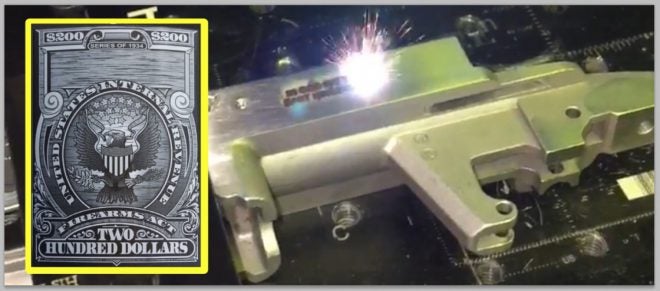The laws and regulations surrounding the National Firearms Act (NFA) can be confusing at best and downright daunting at their worst. In the Part 2 of the Beginner’s Guide to Suppressors we covered the proper completion of the Bureau of Alcohol Tobacco and Firearms (BATFE) Form 4 – Application to Transfer and Register a Firearm. What we haven’t covered (yet) is anything having to do with the BATFE Form 1 – the Application to Make and Register a Firearm, and the subsequent requirements to properly make an NFA item.
NFA firearms that begin their life at a licensed manufacturer are engraved with all of the markings required by law to be included in the registry. These markings are similar to those found on all of your Title 1 (non-NFA) guns: Manufacturer, Serial Number and location of manufacture. However, there are some small, yet very important differences in the engraving requirements for firearms that you make into NFA items.
* Standard disclaimer: I am not an attorney and this is not legal advice. You are responsible for marking your NFA Firearm in accordance with the law.
1) Do I have to engrave my NFA firearm?
First, and most importantly, YES, you have to engrave your Form 1 NFA item to be in proper compliance with the law. Some well established “sources of information” have erroneously reported that engraving is optional unless you plan to later sell your NFA firearm. I’ll repeat it: Every NFA item you make needs to be properly engraved.
2) What needs to be engraved on my NFA firearm?
Name of the individual or entity that made/registered the NFA firearm.
Location (City and State) where the NFA item was made.
Caliber of the registered NFA firearm.
Serial Number of the registered NFA firearm.
Model Number of the registered NFA firearm.*
* See below
EXAMPLE 1: A current firearm to be registered as an NFA firearm:
Let’s say you have just received your approved BATFE Form 1 to register your Colt 6920 as a Short Barreled Rifle (SBR) and it is time to mark your firearm.
Here are the current manufacturer markings (already on the gun and what you used to fill out the information on the Form 1):
COLT
LAW ENFORCEMENT CARBINE
CAL: 5.56MM
SN: 0000001
HARTFORD, CT
What now needs to be engraved by you, as the maker, to be in compliance with the NFA laws:
JOHN SMITH
OR
JOHN SMITH LIVING TRUST
If the item is registered to an entity.
ANYTOWN, CO
The location (City and State) where you actually made the firearm into an an NFA registered item.
Because the manufacturer (remember, you are the maker) already engraved the serial number, model and caliber, you are not required to re-engrave this information.
Let’s say you are building a 9mm suppressor, but it also could be an 80% lower, etc.
What now needs to be engraved by you, as the maker, to be in compliance with the NFA laws:
JOHN SMITH
OR
JOHN SMITH LIVING TRUST
If the item is registered to an entity.
ANYTOWN, CO
The location (City and State) where you actually made the firearm into an an NFA registered item.
SN: 007
The Serial number you created on your Form 1.
CAL: 9MM
Must match your Form 1
MODEL: TFB SILENCER
*A model is not required, but if you included a model on your Form 1, it needs to be engraved.
3) Where on the firearm does this information need to be engraved?
You have some choices: the frame, receiver, barrel, or pistol slide (if applicable) are all acceptable under the law. For practicality purposes, especially with AR-15 type firearms, engraving the lower receiver is usually the best option. As such, you will be able to swap upper receivers without needing to re-engrave the firearm.
4) Other important information:
If the manufacturer engraved the caliber marking as ‘MULTI’ or a similar variant, the maker is required to engrave the the caliber of the NFA firearm as entered on the Form 1. Because most barrels are marked with caliber, these markings will satisfy the requirement as long as they are “conspicuous”. What is conspicuous under the law? It’s a little vague, but as long as someone can see the caliber markings without removing a hand guard, heat shield, shroud, etc, it should be acceptable.
The engraving or stamping (impressing) of the serial number must be to a minimum depth of .003 inch and in a print size no smaller than 1/16 inch. This is important when you are selecting an engraver for your NFA markings – many decorative engravers will not meet the BATFE depth requirement.
The marking regulations apply to all NFA items: SBR’s, Short Barreled Shotguns (SBS), Silencers, Destructive Devices (DD) and Any Other Weapons (AOW).
Some NFA engraving examples:
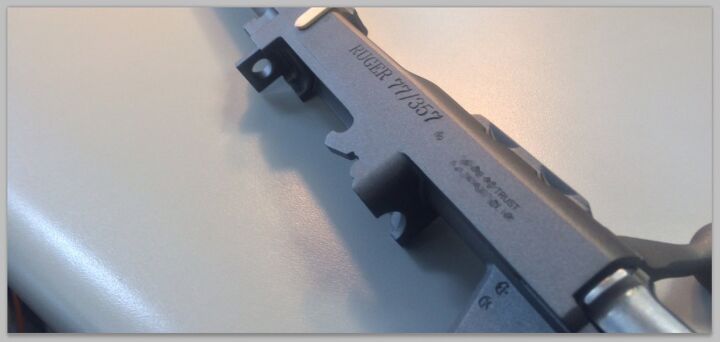
SBR made from a Title I Ruger 77/357 Rifle. The caliber is marked on the barrel.
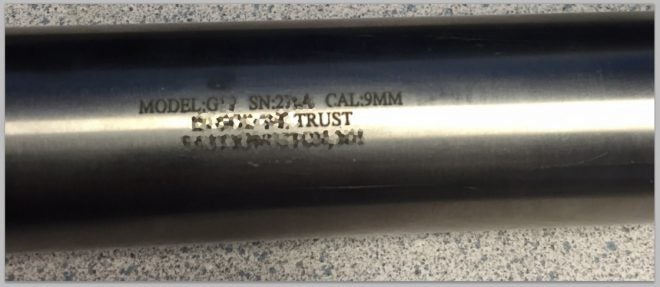
Form 1 Silencer tube.
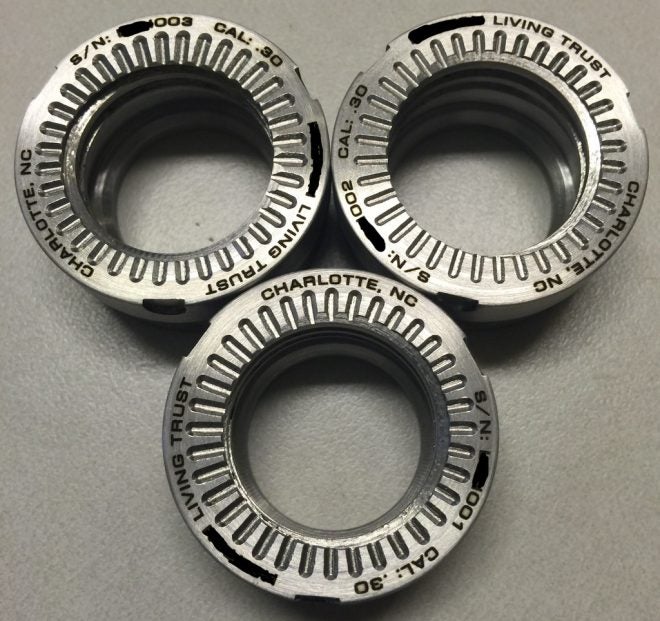
Form 1 Silencer adapters. Note the lack of the optional model number. Credit: BigWaylon
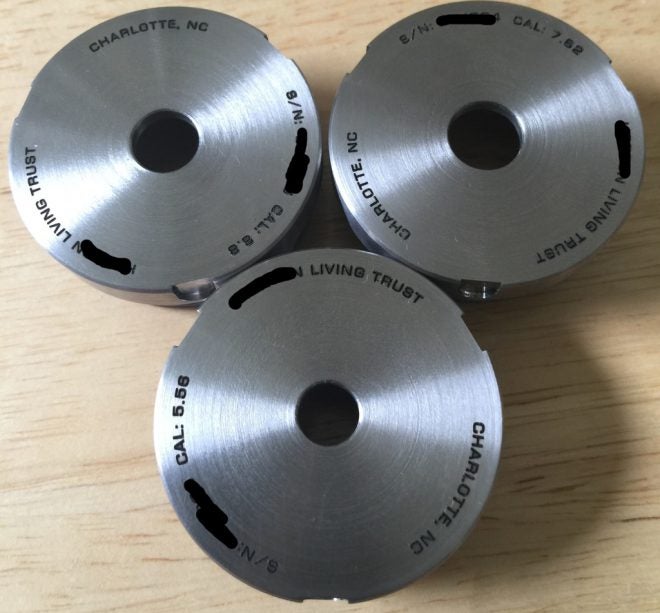
Form 1 Silencer end caps. Note the lack of the optional model number. Credit: BigWaylon
Sources:
From the BATFE NFA Handbook – Chapter 6:
All NFA firearms must be identified by a serial number and other specified markings. If an existing firearm is being used in the making of the NFA weapon, and that firearm is serialized, the existing serial number should be used (unless it duplicates a serial number already used by the maker on Form 1) and entered in Block 4(g). If the weapon is of new manufacture, the applicant must assign a unique serial number and enter it in Block 4(g). For example, a unique serial number could be composed of at least 4 digits preceded by the initials of the maker. NOTE: alpha characters, e.g., a name, will not be accepted as a serial number. If a name is to be used, there must be at least one numeric character in addition to the alpha characters.
The serial number must be engraved or stamped on the receiver of the firearm and the caliber, model, and identification of the maker must be engraved on the barrel or frame or receiver of the weapon. The marking and identification requirements for a maker are the same as for a manufacturer. Refer to section 7.4 for a detailed discussion of the requirements.
While ATF Ruling 2013-3 does not create any new requirements, it does a good job of explaining the process, while quoting the existing regulations.
- The manufacturer, importer, or maker must legibly and conspicuously place on the
frame, receiver, barrel, or pistol slide (if applicable) his/her own name (or
recognized abbreviation) and location (city and State, or recognized abbreviation of
the State) as specified under his/her Federal firearms license (if a licensee); - The serial number adopted must have been marked in accordance with 27 CFR
478.92 and 479.102, including that it must not duplicate any serial number adopted
or placed by the manufacturer, importer, or maker on any other firearm; - The manufacturer, importer, or maker must not remove, obliterate, or alter the
importer’s or manufacturer’s serial number to be adopted, except that, within 15
days of the date of release from Customs custody, a licensed importer must add
letters, numbers, or a hyphen (as described in paragraph 4) to a foreign
manufacturer’s serial number if the importer receives two or more firearms with the
same serial number; - The serial number adopted must be comprised of only a combination of Roman
letters and Arabic numerals, or solely Arabic numerals, and can include a hyphen,
that were conspicuously placed on the firearm; and - If the caliber or gauge was not identified or designated (e.g., marked “multi”) on
the firearm, the manufacturer, importer, or maker must legibly and conspicuously mark the frame, receiver, barrel, or pistol slide (if applicable) with the actual
caliber/gauge once the caliber or gauge is known.
BATFE Form 1 – Page 8 Section j. Description of Firearm and Markings. (7) :
Markings: The maker is required to mark the firearm with his name, city and state. All markings are to be in compliance with 27 CFR 478.92 and 479.102.
Much thanks to BigWaylon for all the guidance on past, present and future NFA nuisances.
 Your Privacy Choices
Your Privacy Choices
